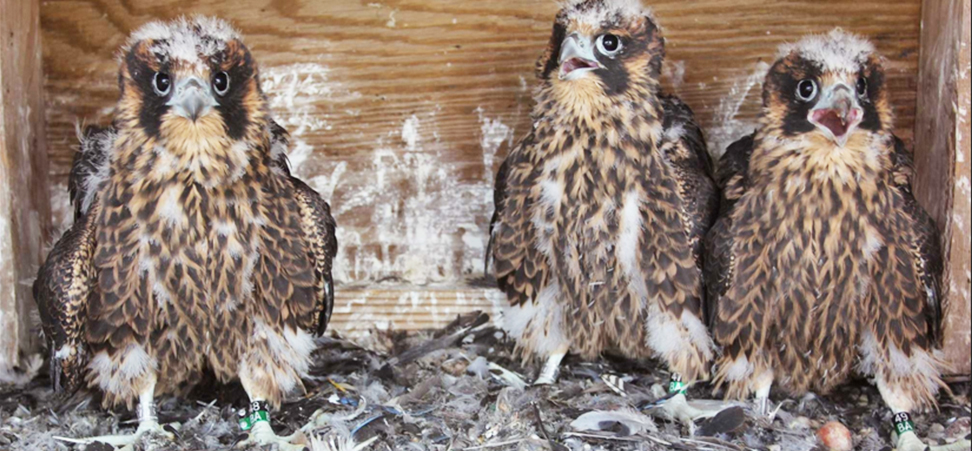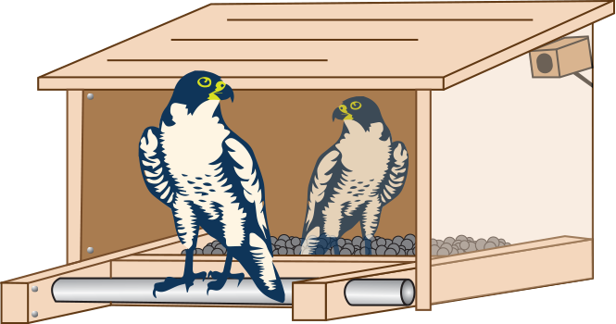
Three falcon chicks were born in the Tappan Zee Bridge nest box in 2013. The New York State Department of Environmental Conservation has named them: Skylar, Shea and Nina. (Photo/New York State Department of Environmental Conservation)

A pair of peregrine falcons reside in a man-made nest box like the one seen here, specially designed to suit their needs, courtesy of New York City Department of Environmental Protection and the New York State Thruway Authority. The interior is filled with loose gravel, much like the loose rocks found on cliff sides. The edge of the box is higher than the interior as well, helping prevent eggs and chicks from falling out. A perch is placed at the entrance of the box to give the adult falcons a place to land. In addition, it allows them to watch the nest, and view the surrounding area for prey and potential danger.
Hundreds of feet above the Hudson, a nest box installed in the steel super structure of the Tappan Zee Bridge provides a home for one of the fastest families on the Hudson River. This peregrine falcon nest box, maintained and monitored by the New York State Thruway Authority, will soon include a webcam accessible online. As construction ramps up this season, the project team is making plans to relocate the falcon nest box from its current location to a new perch high atop the towers of the New NY Bridge.
Thanks to the cooperative efforts of several organizations and many volunteers, nest boxes have helped foster the growth of the falcon population. The nest box on the Tappan Zee Bridge is just one of many installed on New York’s skyscrapers and bridges.
These structures provide alternatives to the preferred nesting sites of peregrines, on the sides of cliffs with sheer drops. The bridge structures provide high vantage points for falcons to scour for and dive after prey with greater ease. During these dives, called stoops, peregrine falcons can reach speeds of more than 200 miles per hour, making them the fastest member of the animal kingdom.
New York has been a leader in falcon conservation, hosting the highest concentration of the species in an urban environment. By installing nest boxes and introducing several falcons throughout the city and tri-state area, their population has risen from a handful of pairs to several dozen.
Their residency has been mutually beneficial. The presence of a peregrine falcon pair on the current bridge deters other birds like seagulls, starlings, and pigeons, which they prey upon. This is especially important since pigeon droppings can deteriorate the structure and create a hazard for motorists. By maintaining a healthy number of falcons, the pigeon population is controlled for a more balanced ecology.
The New NY Bridge project is preserving this trend by making special accommodations for the falcons on the Tappan Zee. A 100-foot buffer area is in place around the existing nest box to help protect falcons during nesting season, which begins in February and ends in August. The nest box will continue to be monitored and maintained at its present location, allowing this pair to remain in the area until a new nest box is constructed in the towers of the New NY Bridge.
Starting in the late spring, you will be able to view the falcons from your computer, smartphone or tablet thanks to the installation of a new, non-invasive webcam. Located inside the nesting box, the webcam will provide a close-up view on the lives of these amazing creatures.
![]() This story is an excerpt from the April Issue of the New NY Bridge Newsletter, a monthly publication designed to keep everyone abreast of the latest news about the project.
This story is an excerpt from the April Issue of the New NY Bridge Newsletter, a monthly publication designed to keep everyone abreast of the latest news about the project.
For more stories and the complete edition of the April newsletter, Click Here
